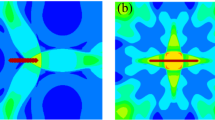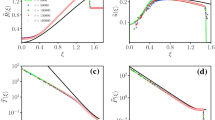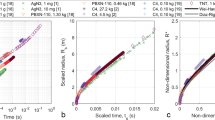Abstract
Interaction of multiple blast waves can be used to direct energy toward a target while simultaneously reducing collateral damage away from the target area. In this paper, simulations of multiple point source explosives were performed and the resulting shock interaction and coalescence behavior were explored. Three to ten munitions were placed concentrically around the target, and conditions at the target area were monitored and compared to those obtained using a single munition. For each simulation, the energy summed over all munitions was kept constant, while the radial distances between target and munitions and the munition initiation times were varied. Each munition was modeled as a point source explosion. The resulting blast wave propagation and shock front coalescence were solved using the inviscid Euler equations of gas dynamics on overlapping grids employing a finite difference scheme. Results show that multiple munitions can be beneficial for creating extreme conditions at the intended target area; over 20 times higher peak pressure is obtained for ten simultaneous munitions compared to a single munition. Moreover, peak pressure at a point away from the target area is reduced by more than a factor of three.











Similar content being viewed by others
References
Aki, T., Higashino, F.: A numerical study on implosion of polygonally interacting shocks and consecutive explosion in a box. In: 17th Proceedings of the International Symposium on Shock Waves and Shock Tubes Current topics in shock waves, Bethlehem, PA, July 17–21, (A91–40576 17–34), pp. 167–172. AIP New York (1990)
Apazidis, N., Lesser, M.: On generation and convergence of polygonal-shaped shock waves. J. Fluid Mech. 309, 301–319 (1996)
Balasubramanian, K., Eliasson, V.: Numerical investigations of the porosity effect on the shock focusing process. Shock Waves 23(6), 583–594 (2013)
Banks, J.W., Aslam, T.D.: Richardson extrapolation for linearly degenerate discontinuities. J. Sci. Comput. 57(1), 1–18 (2013)
Betelu, S., Aronson, D.: Focusing of noncircular self-similar shock waves. Phys. Rev. Lett. 87(7), 074501 (2001)
Book, D., Löhner, R.: Simulation and theory of the quatrefoil instability of a converging cylindrical shock. In: 17th, Proceedings of the International Symposium on Shock Waves and Shock Tubes Current topics in shock waves, Bethlehem, PA, July 17–21, (A91–40576 17–34), pp. 149–154. AIP New York (1990)
Brode, H.L.: Quick estimates of peak overpressure from two simultaneous blast waves. Tech. rep., Tech. Rep. DNA4503T, Defense Nuclear Agency, Aberdeen Proving Ground, MD (1977)
Brown, D.L., Henshaw, W.D., Quinlan, D.J.: Overture: An object-oriented framework for solving partial differential equations on overlapping grids. Object Oriented Methods for Interoperable Scientific and Engineering Computing. SIAM pp. 245–255 (1999)
Chesshire, G., Henshaw, W.: Composite overlapping meshes for the solution of partial differential equations. J. Comput. Phys. 90(1), 1–64 (1990)
Demmig, F., Hemmsoth, H.H.: Model computation of converging cylindrical shock waves—initial configurations, propagation, and reflection. In: 17th, Proceedings of the International Symposium on Shock Waves and Shock Tubes Current topics in shock waves, Bethlehem, PA, July 17–21, (A91–40576 17–34), pp. 155–160. AIP New York (1990)
Dimotakis, P.E., Samtaney, R.: Planar shock cylindrical focusing by a perfect-gas lens. Phys. Fluids 18, 031,705 (2006)
Eliasson, V., Apazidis, N., Tillmark, N.: Shaping converging shock waves by means of obstacles. J. Vis. 9, 240 (2006)
Eliasson, V., Apazidis, N., Tillmark, N.: Controlling the form of strong converging shocks by means of disturbances. Shock Waves 17, 29–42 (2007)
Eliasson, V., Apazidis, N., Tillmark, N., Lesser, M.: Focusing of strong shocks in an annular shock tube. Shock Waves 15, 205–217 (2006)
Glass, I.: Shock Waves and Man. The University Toronto Press, Toronto (1974)
Guderley, G.: Starke kugelige und zylindrische Verdichtungsstöße in der Nähe desKugelmittelpunktes bzw. der Zylinderachse. Luftfahrt Forsch. 19, 302–312 (1942)
Henshaw, W.D., Schwendeman, D.W.: Parallel computation of three-dimensional flows using overlapping grids with adaptive mesh refinement. J. Comput. Phys. 227(16), 7469–7502 (2008)
Hikida, S., Needham, C.E.: Low amplitude multiple burst (lamb) model. Tech. rep., S-cubed Final Report, S-CUBED-R-81-5067 (1981)
Hosseini, S.H.R., Takayama, K.: Implosion of a spherical shock wave reflected from a spherical wall. J. Fluid Mech. 530, 223–239 (2005)
Jiang, Z., Takayama, K., Moosad, K.P.B., Onodera, O., Sun, M.: Numerical and experimental study of a micro-blast wave generated by pulsed-laser beam focusing. Shock waves 8, 337–349 (1998)
Kandula, M., Freeman, R.: On the interaction and coalescence of spherical blast waves. Shock waves 18, 21–33 (2008)
Keefer, J.H., Reisler, R.E.: Simultaneous and non-simultaneous multiple detonations. In: Proceedings of the 14th International Symposium Shock waves and shock tubes, New South Wales, Australia, pp. 543–552 (1984)
Kjellander, M.K., Tillmark, N.T., Apazidis, N.: Experimental determination of self-similarity constant for converging cylindrical shocks. Phys. Fluids 23(11), 116103 (2011)
Kjellander, M.K., Tillmark, N.T., Apazidis, N.: Energy concentration by spherical converging shocks generated in a shock tube. Phys. Fluids 24(12), 126103 (2012)
Knystautas, R., Lee, B., Lee, J.: Diagnostic experiments on converging detonations. Phys. Fluids. Suppl. 1, 165–168 (1969)
Matsuo, M., Ebihara, K., Ohya, Y.: Spectroscopic study of cylindrically converging shock waves. J. Appl. Phys. 58(7), 2487–2491 (1985)
Needham, C.E.: Blast Waves. Shock Wave and High Pressure Phenomena. Springer, Berlin Heidelberg (2010)
Neemeh, R.A., Ahmad, Z.: Stability and collapsing mechanism of strong and weak converging cylindrical shock waves subjected to external perturbation. In: Proceedings of the 15th International Symposium Shock waves and shock tubes, Berkeley, CA, pp. 423–430. Stanford Univ. Press (1986)
Perry, R.W., Kantrowitz, A.: The production and stability of converging shock waves. J. Appl. Phys 22, 878–886 (1951)
Roig, R., Glass, I.: Spectroscopic study of combustion-driven implosions. Phys. Fluids 20(10), 1651–1656 (1977)
Roy, C.J.: Review of discretization error estimators in scientific computing. AIAA Paper 2010–0126 (2010)
Saito, T., Glass, I.: Temperature measurements at an implosion focus. Proc. R. Soc. Lond. A 384, 217–231 (1982)
Schwendeman, D.W.: On converging shock waves of spherical and polyhedral form. J. Fluid Mech. 454, 365–386 (2002)
Schwendeman, D.W., Whitham, G.B.: On converging shock waves. Proc. R. Soc. Lond. A 413, 297–311 (1987)
Shao-Lin, L.: Cylindrical shock waves produced by instantaneous energy release. J. Appl. Phys. 25(1), 54–57 (1954)
Starkenberg, J.K., Benjamin, K.J.: Predicting coalescence of blast waves from sequentially exploding ammunition stacks. Tech. rep., Army Research Lab Report ARL-TR-645 (1994)
Takayama, K., Kleine, H., Grönig, H.: An experimental investigation of the stability of converging cylindrical shock waves in air. Exp. Fluids 5, 315–322 (1987)
Takayama, K., Onodera, O., Hoshizawa, Y.: Experiments on the stability of converging cylindrical shock waves. Theor. Appl. Mech. 32, 305–329 (1984)
Taylor, G.: The formation of a blast wave by a very intense explosion. I. Theoretical discussion. In: Proceedings of the Royal Society of London. Series A Mathematical and Physical Sciences pp. 159–174 (1950)
Watanabe, M., Onodera, O., Takayama, K.: Shock wave focusing in a vertical annular shock tube. Theor. Appl. Mech 32, 99–104 (1995)
Whitham, G.B.: Linear and nonlinear waves. Wiley, New York (1974)
Wu, J., Neemeh, R., Ostrowski, P.: Experiments on the stability of converging cylindrical shock waves. AIAA J. 19, 257–258 (1981)
Yeghiayan, R.P., Lee, W.N., Walsh, J.P.: Blast and thermal effects of multiple nuclear burst exposure of aircraft in a base-escape mode (ada058301). Tech. rep., No. KA-TR-146. Kaman Avidyne Burlington, MA (1977)
Acknowledgments
We wish to thank the Center for High-Performance Computing at University of Southern California for providing free access to computing resources. We also wish to thank Prof. Bill Henshaw at Rensselear Polytechnic Institute for help with Overture.
Author information
Authors and Affiliations
Corresponding author
Additional information
Communicated by A. Podlaskin.
This paper is based on work that was presented at the 21st International Symposium on Shock Interaction, Riga, Latvia, August 3–8, 2014.
Rights and permissions
About this article
Cite this article
Qiu, S., Eliasson, V. Interaction and coalescence of multiple simultaneous and non-simultaneous blast waves. Shock Waves 26, 287–297 (2016). https://doi.org/10.1007/s00193-015-0567-2
Received:
Revised:
Accepted:
Published:
Issue Date:
DOI: https://doi.org/10.1007/s00193-015-0567-2




